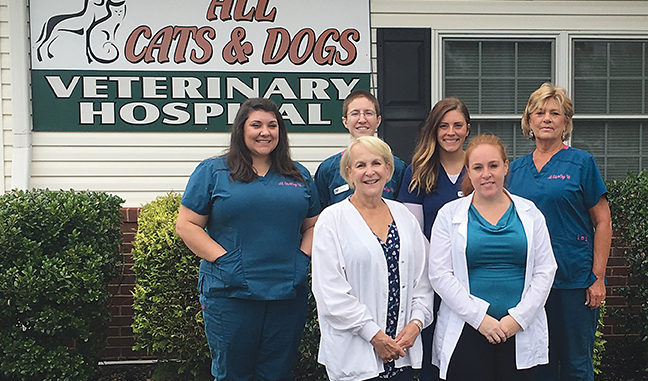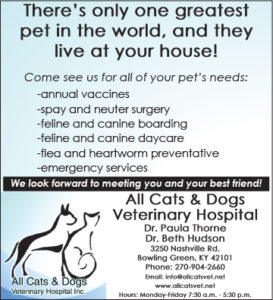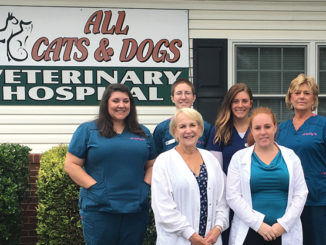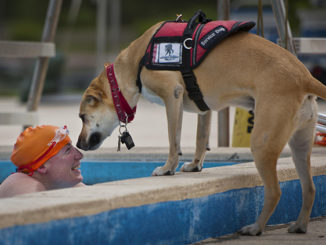
For grain’s sake! – Exploring the truth behind the grain-free revolution
by Jessica Mann
You’ve seen the commercial: A wolf running alongside a dog while a superimposed voice declares that YOUR dog is a descendant of these wild
canines, and so they must eat like these wild animals once ate. This diet includes lots of protein, but no grains. Cue the grain-free revolution. Now, every shelf in the pet food aisle is stocked with bags and cans that proudly declare they are “grain-free.” But what does this actually mean? And how do you know that it’s the right choice for your pet? For years consumers have been bombarded with grain-free rhetoric in the form of fancy packaging and commercials that run on endless loops. The more we see it, the better we think it must be and that’s exactly what pet food companies count on. Jennifer Larsen, a clinical nutritionist at the University of California Veterinary School in Davis, agrees. “Grain-free is definitely a marketing technique that has been very successful… (people) are buying an idea, not necessarily a superior product.”
Grains are not bad for dogs and cats. In fact, plenty of research has been conducted that debunks this myth entirely. For example, the Clinical Nutrition Team at the Cummings Veterinary Medical Center at Tufts University found that “there is no reliable evidence that suggests that it is harmful to feed grains as a group to dogs or cats.” It’s true that humans often have grain-related allergies, but the same is not true for pets. Food allergies in dogs and cats will more often be in response to ingredients that they are most exposed to, like “animal proteins such as chicken, beef, and dairy,” according to the team at Tufts University.
The idea that dogs and cats need to eat like their ancestors is outdated and wrong. As wild dogs and cats became domesticated, their nutritional needs evolved and changed. Through his research, Robert Wayne, a canine geneticist at UCLA, found that dogs “have adapted to a human diet,” and “that most wolves carry two copies of a gene involved in starch digestion, while dogs have between 3 and 29 copies…(so) the average dog can easily handle 50 percent of its diet as carbs.” Veterinary nutritionists have also found that “cats can digest and utilize carbohydrates quite well.”
Additionally, the quality of life for a wild dog or cat was drastically different than it is now. For instance, their life spans were much shorter because they were in constant danger of attack from predators. Now, domesticated animals live longer indoors or in small outdoor areas rather than run wild like their feral counterparts. This means that their energy levels and needs have drastically decreased. A dog or cat that rarely leaves the house or yard simply doesn’t need to eat the same diet as wolf or a tiger.
Furthermore, recent studies have found that grain-free diets may actually be making our dogs and cats sick. According to Dr. Lisa M. Freeman of the Cummings Veterinary Medical Center at Tufts University, veterinary cardiologists “have been reporting increased rates of DCM in dogs.” Dilated cardiomyopathy, a disease of the heart muscle that causes a weak heartbeat and enlarged heart in dogs and cats, has been diagnosed in higher numbers in both species. Research has found the common factor between the species is their diet. Most, if not all, of these pets have been eating “boutique, grain-free diets.” Researchers now wonder if there is a link between DCM and grain-free foods because these particular diets have insufficient levels of taurine, an essential amino acid that is crucial to heart health. Since taurine isn’t manufactured naturally in the body, it’s vital that it be found in dog and cat food. Dr. Freeman suggests that the reason DCM is on the rise is because grain-free diets rely heavily on unusual protein sources.
“Exotic ingredients have different nutritional profiles and different digestibility than typical ingredients, and also have the potential to affect the metabolism of other nutrient,” Dr. Freeman reported. Ingredients aren’t the only culprit. Quality control and nutritional proficiency are also key in creating a nutritionally sound diet. According to Dr. Freeman, “If companies don’t have the quality control to ensure all nutrients are at the minimum levels, deficiencies could occur and could contribute to DCM…and DCM could even be the result of an ingredient in the diet that is toxic to the heart.” In order to ensure that you’re feeding your pet a well-balanced diet it’s essential to speak with your veterinarian. Allow your veterinarian to have an honest and open conversation about the specific nutritional and medical needs of your pet. If they suggest a diet change, don’t be offended. There are many nutritionally viable dog and cat food options besides grain-free diets. Some of these can be found at your local pet store while others can be bought only at a veterinarian’s office. But please remember, your veterinarian isn’t looking to “make money” by offering a different food. Your veterinarian, and their team, genuinely have your pet’s best interest in mind and only make suggestions in order to enhance your dog or cat’s quality of life. A grain-free diet can’t promise a long, healthy life for your dog or cat, but a discussion with your veterinarian can.
About the Author:
Jessica Mann has worked as the Client Care Specialist at All Cats & Dogs Veterinary Hospital since 2009. Most days you can find her behind the front desk fielding phone calls and cuddling puppies and kittens. She is a recent graduate of WKU with a degree in English literature.



